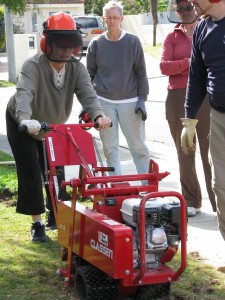
The best practice for removing lawn, in my experience, is either using a sod cutter or a flat shovel to cut under the rhizomes. If you spray with chemicals then you just have dead grass that you now have to handle directly with the cancer causing chemicals on it. However it does not kill the rhizomes! Only the foliage, hence the term defoliant. Rototilling breaks the rhizomes into neat ½” and ¼” pieces if it doesn’t wind around the till. Bermuda and Augustine grass can regrow from ¼” or smaller pieces of rhizome bits. This means that you will have a nice healthy lawn all neatly de-thatched within a week after you rototill! =]
Sod cutters are available for rent at A-1 rentals, some Home-Depots, USA Rentals etc. set it for the 6” depth and then run it along like a vacuum cleaner with nice straight lines up and down the lawn area. Then go through and using a flat shovel cut into two to three foot lengths so you can move them easier. I suggest piling them onsite to allow to dry out and reclaim the soil from the rhizomes. This also reduces the weight for waste hauling costs. Remember the rhizomes cannot be put into green waste only trash. If they find grass rhizomes in a truck hauling green waste they transfer the entire truck haul to landfill. Rhizomes will not die during hot composting and are considered an invasive pest for green waste facilities.
Another good technique would be to solarize the area after you have removed as much of the sod as possible and gone through the area for any rhizomes not removed in this manner. Solarizing is a method of seed and root kill by placing a large CLEAR polyethylene sheet over the area, sealed to the ground at the edges with bermed soil. Then left onsite for 3-4 weeks. The heat buildup will sterilize the soil, hopefully killing the remaining rhizomes. Two caveats, 1. This kills EVERYTHING in the soil good and bad 2. Bermuda and Augustine Grass are highly resistant to chemicals and heat applications. Rancho Santa Ana Botanic Garden found that the Bermuda grass under an area they solarized did not completely die. One rhizome grew over twenty feet to escape under the edge of the plastic. Most of the Bermuda grass present did die, but this rhizome persisted. This just clearly points out that there is no one silver bullet. It is a mixture of different physical techniques that work in the long run with persistence. Once you have accomplished these steps the war of attrition begins. This entails pulling any green you see that may pop up from stray rhizomes. Just 6 hours of daylight allows the rhizome to store another 30 days of starch so you must pull it as soon as see it. Don’t allow yourself the luxury “I’ll pull that when I get home.” Unfortunately that leads to a very long battle indeed.
Best of luck!
– Reginald Durant, Executive Director, Back to Natives
